ACUFO-1945-00-00-SUZUKA-1
The photograph below appeared in several coffee-table books about UFOs in the 1980 - 1990:
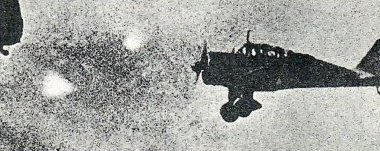
|
The various captions claimed that it is a “rare photograph” of the Foo Fighters of WWII.
Most captions did not tell where it was taken, who took it and when. In some instance it was said it is a Foo Fighter as “seen by the Allies”; ufologist John Spencer said it was “taken in 1944 over Germany,” or “Luftwaffe, Germany, 1944.”
The first serious examination of the image was apparently done by Robert Bull, in the ufology bulletin BUFORA Bulletin, of the British UFO Research Association (BUFORA), in December 1998.
Bull determined that the plane was the Japanese plane Tachikawa Ki-36, named “Ida” by the Allies, or probably its new version Ki-55. Quite obsolete in WWII against the Allied fighter planes, it was mostly used over China, as a trainer or liaison plane.
Bull also learned that the image had appeared in Paul Dong's book “UFOS over China” (1983), and, from US ufologist Jan Aldrich, he learned that the image originated with the “Cosmic Brotherhood Association” (C.B.A) UFO group in Japan, of which late ufologist Jun-Tchi Takanashi said that all their “Foo-fighter” photographs were spurious, published without pedigree.
Going back from rare source to rare source, I found the photo in a 1975 book of UFO photos by the Italian authors Gianfranco de Turris and Sebastiano Fusco, in which it was indicated that it was taken in 1945 in the Suzuka Mountains, in central Japan, by one of the pilots of the Japanese fighter squadron named by the Allies Ida 98, the Takikawa-Kawasaki Type 98 - T. 36.
An essential piece is the information by the Italian ufologist Giuseppe Stilo in 1997. He discussed the alleged photos of “Foo-Fighters” alleged to come from the Japanese aviation during World War II, which are find in numerous books giving no source. He explained that ufologists specializing in “Foo-Fighters” are not aware of any well-documented report linked to these photos, and that consultations with these ufologists revealed that they have a unique and very questionable source.
The source, he indicated, dating from 1963 and 1964, was the Japanese “contactee” group “Cosmic Brotherhood Association”, led by Yusuke J. Matsumura. They had published numerous photos, none of which had a source from Western ufology.
A first series of these photos was published by the CBA in the second issue of their 1963 Flying Saucer News newsletter.
Stilo explained that in the mid-1950s, Yusuke Matsumura distributed mimeographed bulletins in English on behalf of a small group of enthusiasts called the “Flying Saucer Research Group”; that in 1958, in Yokohama, he created the “CBA International (Cosmic Brotherhood Association)” with the administrator in Japan of the American contactee George Adamski, Hachiro Kubota, and launched the small magazine Flying Saucer News. Matsumura then claimed to have met the “Space Brothers” himself, who had taken him into their spaceship (etc.). From 1957, Matsumura released dozens of photos of unusual clouds, claiming that they were spaceships that he had photographed himself. He ended up setting up a real apocalyptic sect and practicing fraud, having money paid to him by his disciples whom his extraterrestrial friends were supposed to save from the near end of the world. He continued to publish so-called UFO photos, faked by him.
Stilo commented on the present image noting that it is perhaps the most reproduced of all these images, and shows a formation of Tachikawa Ki 36 Mod 48 Ida two-seater trainer aircraft, and between the two planes, cluster or triangular lights. The caption indicated that it was taken in 1945 in the Suzuka Mountains in central Japan, according to Justo Miranda and Pedro Mercado, in their text “Strange Phenomena in the German Sky”, The Reichdreams Research Service (File No. 11, Madrid, published by Autori presse, undated but probably from 1995. (These two authors can be found on the Luft46 Website). They identified the two planes as “three” Tachikawa Ki 55 trainers (not Ki 36) of the Imperial Army's flight school based in Kumagaya, but did not say where they got this information, nor the date and location, from.
| Date: | 1945 |
|---|---|
| Time: | Day. |
| Duration: | ? |
| First known report date: | 1983 |
| Reporting delay: | 4 decades. |
| Country: | Japan |
|---|---|
| State/Department: | Kansai or Tokai or Chubu |
| City or place: | Suzuka mountain range. |
| Number of alleged witnesses: | 1 |
|---|---|
| Number of known witnesses: | ? |
| Number of named witnesses: | 0 |
| Reporting channel: | UFO group, UFO book. |
|---|---|
| Visibility conditions: | ? |
| UFO observed: | ? |
| UFO arrival observed: | ? |
| UFO departure observed: | ? |
| UFO action: | |
| Witnesses action: | |
| Photographs: | No. |
| Sketch(s) by witness(es): | No. |
| Sketch(es) approved by witness(es): | No. |
| Witness(es) feelings: | ? |
| Witnesses interpretation: | ? |
| Sensors: |
[X] Visual: 1?
[ ] Airborne radar: N/A. [ ] Directional ground radar: [ ] Height finder ground radar: [X] Photo: Yes. [ ] Film/video: [ ] EM Effects: [ ] Failures: [ ] Damages: |
|---|---|
| Hynek: | ? |
| Armed / unarmed: | 1 7.62 mm nachine gun. |
| Reliability 1-3: | 1 |
| Strangeness 1-3: | 1 |
| ACUFO: | Probable reflections on cockpit. |
[Ref. rpi1:] ROBERTO PINOTTI:
[...] at the end of the war, quite a few Japanese pilots could have easily recognized those phantom objects in the disconcerting disc-shaped luminous devices that their "Ida 98" fighters had encountered and photographed in 1945 on the Suzuka Mountains, in central Japan, during a reconnaissance action. Simple coincidences? Perhaps.
[Ref. tfo1:] GIANFRANCO DE TURRIS AND SEBASTIANO FUSCO:
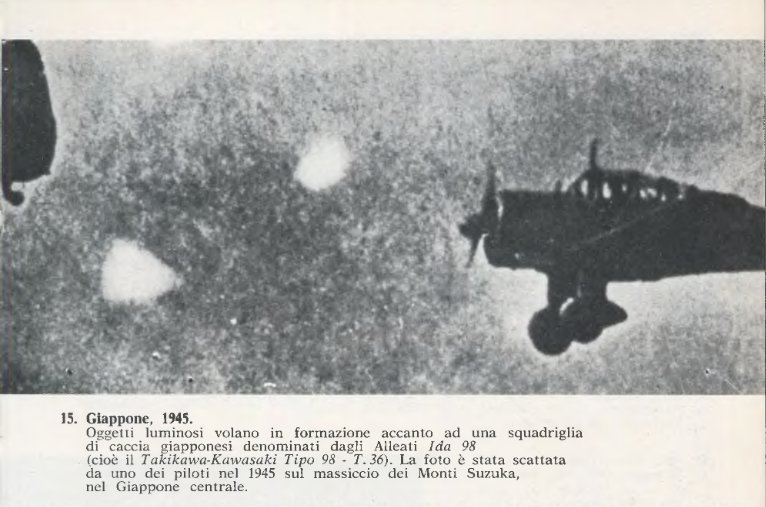
|
15. Giappone, 1945.
Oggetti luminosi volano in formazione ad una squadriglia di caccia giapponesi denominati dagli Alleati Ida 98 (cioè il Takikawa-Kawasaki Tipo 98 - T. 36). La foto è stata scattata da uno dei piloti nel 1945 sul massiccio ei Monti Suzuka, nel Giappone centrale.
I.e.:
15. Japan, 1945.
Luminous objects fly in formation to a squadron of Japanese fighters named by the Allies Ida 98 (i.e. the Takikawa-Kawasaki Type 98 - T. 36). The photo was taken by one of the pilots in 1945 on the Suzuka Mountains in central Japan.
[Ref. ibl1:] ILLOBRAND VON LUDWIGER:

|
Image 3:
Foo Fighters over Japan in 1945.
The photo shows glowing fireballs flying ahead of a Takikawa-Kawasaki 98-T36 aircraft. It was taken by a pilot over the Suzuka mountain range in central Japan. (Source: Obiettivo sugli ufo/turris+fusco 1975)
[Ref. wsd1:] WENDELLE STEVENS AND PAUL DONG:
1942, Suzuka Mountains, Central Japan
Two small luminous cone-shaped objects were photographed in flight in the middle of a close formation of two Japanese Tachikawa Ki-36, Army Type 98 Reconnaissance airplanes, flying over the Suzuka Mountain Range of Central Japan. The objects seen in the photograph appear to be very small and dangerously close to the airplanes in flight, occupying a position directly between them, and the aircraft were no more than a plane-length apart when the photograph was made.
A cropped version of the image appears below the above report:

|
It has this caption:
1942, Suzuka Mountains, Central Japan. Two small luminous cone-shaped objects were photographed in the midst of a formation of Tachikawa Ki-36, Army Type 98 Reconnaissance airplanes in flight.
[Ref. odb1:] "OVNIS: UN DOSSIER BRULANT":

|
The cropped photo appears in this book with the caption:
One of the rare photographs of the mysterious balls of fire seen by Allied planes during the Second World War.
[Ref. lpo1:] "LE PHENOMENE DES OVNI":
The same photo as below appears in this book with the caption:
Inexplicable balls of fire, the “foo fighters”, grazed the planes of both camps during the last war.
[Ref. jsr1:] JOHN SPENCER:
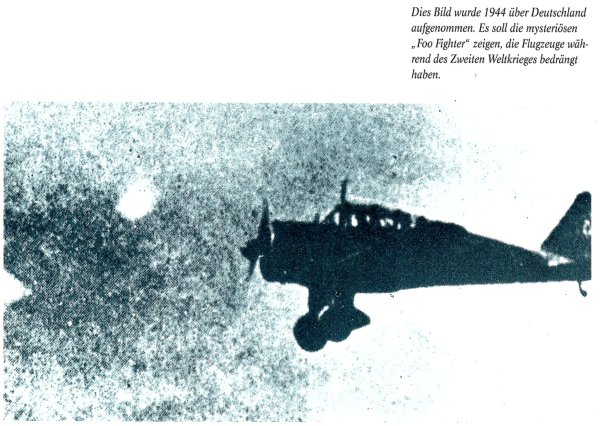
|
The cropped photo appears in this book with the caption:
This photograph was taken in 1944 over Germany. It is supposed to show the mysterious “Foo Fighter”, which followed planes during World War II.
[Ref. ues1:] "UFO ENCOUNTERS":
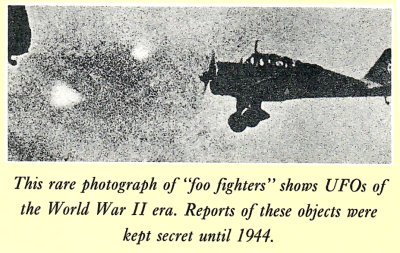
|
This rare photograph of “foo fighters” shows UFOs of the World War II era. Reports of these objects were kept secret until 1944.
In the picture credits of the book, this photo is credited to “Picture Library”.
[Ref. ofr1:] OMAR FOWLER:
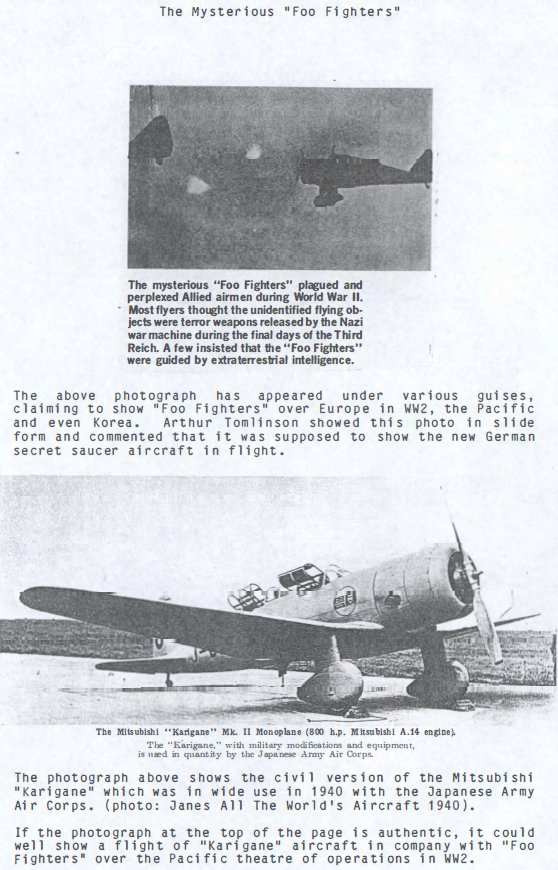
|
The mysterious “Foo Fighters” plagued and perplexed Allied airmen during World War II. Most flyers thought the unidentified flying objects were terror weapons released by the Nazi war machine during the final days of the Third Reich. A few insisted that the “Foo Fighters” were guided by extraterrestrial intelligence.
The above photograph has appeared under various guises, claiming to show “Foo Fighters” over Europe in WW2, the Pacific and even Korea. Arthur Tomlinson showed this photo in slide form and commented that it was supposed to show the new German secret saucer aircraft in flight.
The Mitsubishi “Karigane” Mk. II Monoplane (800 h.p. Mitsubishi A.14 engine).
The “Karigane,” with military modifications and equipment, is used in quantity by the Japanese Army Air Corps. The photograph above shows the civil version of the Mitsubishi “Karigane” which was in wide use in 1940 with the Japanese Army Air Corps. (photo: Janes All The World's Aircraft 1940). If the photograph at the top of the page is authentic, it could well show a flight of “Karigane” aircraft in company with “Foo Fighters” over the Pacific theatre of operations in WW2.
[...] where is the evidence to support the ever increasing claims that “Foo Fighters” were seen frequently over Europe during Allied WW2 bombing missions?
The European reports appear to be totally unsubstantiated and have been seized upon by a number of authors without proper research and so the myth increases with each telling.
[Ref. gso1:] GIUSEPPE STILO:
This Italian UFO researcher discusses alleged “Foo-Fighter“ photos which would come from Japanese aviation during the Second World War, which were published in numerous books giving no source. He explains that ufologists specializing in «Foo-Fighter« are not aware of any well-documented reports that would be linked to these photos, and that consultations with these ufologists revealed that they have a unique and very questionable source.
The source, dating from 1963 and 1964, was the Japanese “contactee” group “Cosmic Brotherhood Association”, led by Yusuke J. Matsumura. They had published numerous photos, none of which had a source from Western ufology.
A first series was published by the CBA in the second issue of the 1963 newsletter Flying Saucer News.

|
Stilo commented the above picture:
Photo 7 - is perhaps the most reproduced of all these images. A formation of Tachikawa Ki 36 Mod. 48 Ida two-seat trainer aircraft, between two planes, displays cluster or triangular lights. The caption says it was taken in 1945 in the Suzuka Mountains of central Japan (11);
[...other case...]
(11) Justo Miranda and Pedro Mercado, Madrid enthusiasts of the lesser known and more controversial aspects of aviation history, in their text Strange Phenomena in the German Sky, The Reichdreams Research Service (Dossier n. 11, Madrid, published by Autori press, undated but probably 1995) identify the aircraft as three Tachikawa Ki 55 (not 36) trainers from the Imperial Army Flight School based in Kumagaya. It should be noted, however, that these authors do not cite any sources supporting this or other unpublished information.
Stilo explains that in the mid-1950s, Yusuke Matsumura distributed mimeographed bulletins in English on behalf of a small group of enthusiasts called the “Flying Saucer Research Group”; that in 1958, in Yokohama, he created the “CBA International (Cosmic Brotherhood Association)” with the administrator in Japan of the American contactee George Adamski, Hachiro Kubota, and launched the small magazine “Flying Saucer News”. Matsumura then claimed to have met the “Space Brothers” himself, who took him into their spaceship (etc.). From 1957 on, Matsumura released dozens of photos of unusual clouds, claiming that they were spaceships that he had photographed himself. He ended up setting up a real apocalyptic sect and practicing fraud, having money paid to him by his disciples whom his extraterrestrial friends were supposed to save from the soon to come end of the world, which did not happen. He continued to publish alleged photos of UFOs, faked by him.
[Ref. bua1:] ROBERT BULL - "BUFORA BULLETIN":
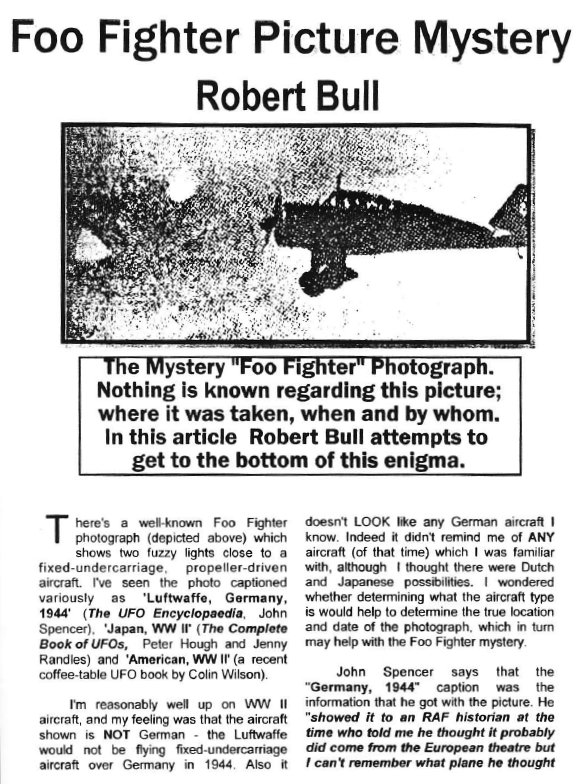
|
Robert Bull
The Mystery “Foo Fighter” photograph
Nothing is known regarding this picture; where it was taken, when and by whom. ln this article Robert Bull attempts to get to the bottom of this enigma.
There's a well-known Foo Fighter photograph (depicted above) which shows two fuzzy lights close to a fixed-undercarriage, propeller-driven aircraft. I've seen the photo captioned variously as 'Luftwaffe, Germany, 1944' (The UFO Encyclopaedia, John Spencer}, 'Japan, WW II' (The Complete Book of UFOs, Peter Hough and Jenny Randles) and 'American, WW II' (a recent coffee-table UFO book by Colin Wilson).
I'm reasonably well up on WW II aircraft, and my feeling was that the aircraft shown is NOT German - the Luftwaffe would not be flying fixed-undercarriage aircraft over Germany in 1944. Also it doesn't LOOK like any German aircraft I know. Indeed it didn't remind me of ANY aircraft (of that time} which I was familiar with, although I thought there were Dutch and Japanese possibilities. I wondered whether determining what the aircraft type is would help to determine the true location and date of the photograph, which in turn may help with the Foo Fighter mystery.
John Spencer says that the “Germany, 1944” caption was the information that he got with the picture. He “showed it to an RAF historian at the time who told me he thought it probably did come from the European theatre but I can't remember what plane he thought”
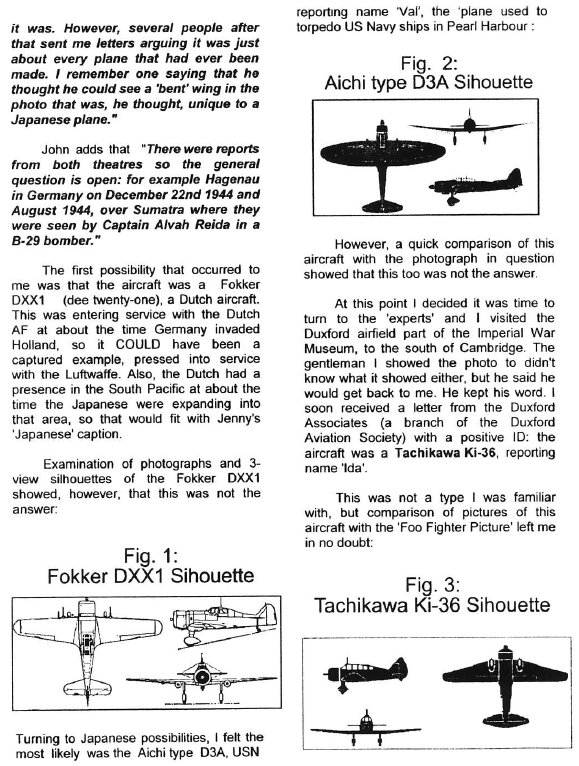
|
it was. However, several people after that sent me letters arguing it was just about every plane that had ever been made. I remember one saying that he thought he could see a 'bent' wing in the photo that was, he thought, unique to a Japanese plane.”
John adds that “There were reports from both theatres so the general question is open: for example Hagenau in Germany on December 22nd 1944 and August 1944, over Sumatra where they were seen by Captain Alvah Reida in a B-29 bomber.”
The first possibility that occurred to me was that the aircraft was a Fokker DXX1 (dee twenty-one), a Dutch aircraft. This was entering service with the Dutch AF at about the time Germany invaded Holland, so it COULD have been a captured example, pressed into service with the Luftwaffe. Also, the Dutch had a presence in the South Pacific at about the time the Japanese were expanding into that area, so that would fit with Jenny's 'Japanese' caption.
Examination of photographs and 3-view silhouettes of the Fokker DXX 1 showed, however, that this was not the answer:
Fig. 1:
Fokker DXXI Silhouette
[Fokker DXXI silhouette.]
Turning to Japanese possibilities, I felt the most likely was the Aichi type D3A, USN reporting name 'Val', the plane used to torpedo US Navy ships in Pearl Harbour:
Fig. 2:
Aichi type D3A Silhouette
[Aichi type D3A silhouette.]
However, a quick comparison of this aircraft with the photograph in question showed that this too was not the answer.
At this point I decided it was time to turn to the 'experts' and I visited the Duxford airfield part of the Imperial War Museum, to the south of Cambridge. The gentleman I showed the photo to didn't know what it showed either, but he said he would get back to me. He kept his word. I soon received a letter from the Duxford Associates (a branch of the Duxford Aviation Society) with a positive lD: the aircraft was a Tachikawa Ki36, reporting name 'Ida'.
This was not a type I was familiar with, but comparison of pictures of this aircraft with the 'Foo Fighter Picture' left me in no doubt:
Fig.3:
Tachikawa Ki-36 Silhouette
[Tachikawa Ki-36 silhouette.]
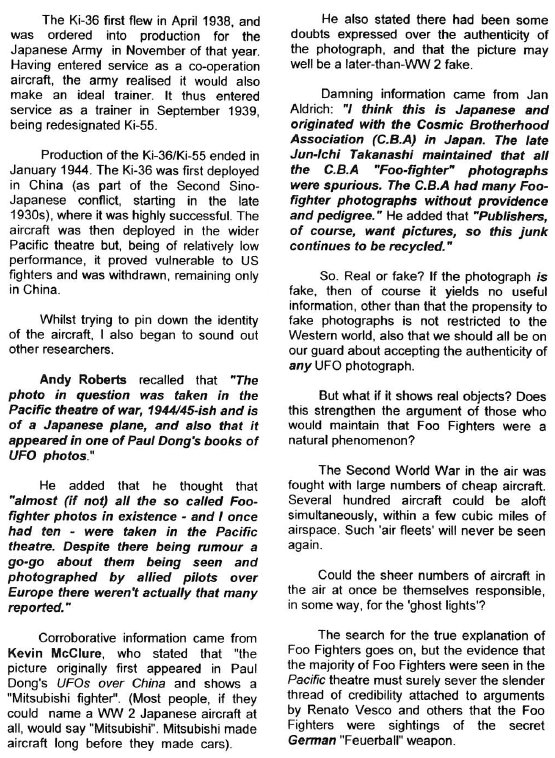
|
The Ki-36 first flew in April 1938, and was ordered into production for the Japanese Army in November of that year. Having entered service as a co-operation aircraft, the army realised it would also make an ideal trainer. lt thus entered service as a trainer in September 1939, being redesignated Ki-55.
Production of the Ki-36/Ki-55 ended in January 1944. The Ki-36 was first deployed in China (as part of the Second Sino-Japanese conflict, starting an the late 1930s), where it was highly successful. The aircraft was then deployed in the wider Pacific theatre but, being of relatively low performance, it proved vulnerable to US fighters and was withdrawn, remaining only in China.
Whilst trying to pin down the identity of the aircraft, I also began to sound out other researchers.
Andy Roberts recalled that “The photo in question was taken in the Pacific theater of war, 1944-1945-ish and is of a Japanese plane, and also that it appeared in one of Paul Dong's books of UFO photos.”
He added that he thought that “almost (if not all the so called Foofighter photos in existence - and I once had ten - were taken in the Pacific theater. Despite there being rumour a go-go about them being seen and photographed by allied pilots over Europe there were'nt actually that many reported.”
Corroborative information came from Kevin Mcclure, who stated that “the picture originally first appeared in Paul Dong's UFOS over China and shows a “Mitsubishi fighter'. (Most people, if they could name a WW 2 Japanese aircraft at all, would say “Mitsubishi”. Mitsubishi made aircraft long before they made cars).
He also stated there had been some doubts expressed over the authenticity of the photograph, and that the picture may well be a later-than-WW 2 fake.
Damning information came from Jan Aldrich: “I think this is Japanese and originated with the Cosmic Brotherhood Association (C.B.A) in Japan. The late Jun-Tchi Takanashi maintained that all the C.B.A “Foo-fighter” photographs were spurious. The C.B.A had many Foofighter photographs without providence and pedigree.” He added that “Publishers, of course, want pictures, so this junk continues to be recycled.”
So. Real or fake? lf the photograph is fake, then of course it yields no useful information, other than that the propensity to fake photographs is not restricted to the Western world, also that we should all be on our guard about accepting the authenticity of any UFO photograph.
But what if it shows real objects? Does this strengthen the argument of those who would maintain that Foo Fighters were a natural phenomenon?
The Second World War in the air was fought with large numbers of cheap aircraft. Several hundred aircraft could be aloft simultaneously, within a few cubic miles of airspace. Such 'air fleets' will never be seen again.
Could the sheer numbers of aircraft in the air at once be themselves responsible, in some way, for the 'ghost lights'?
The search for the true explanation of Foo Fighters goes on, but the evidence that the majority of Foo Fighters were seen in the Pacific theatre must surely sever the slender thread of credibility attached to arguments by Renato Vesco and others that the Foo Fighters were sightings of the secret German “Feuerball” weapon.
[Ref. rpi2:] ROBERTO PINOTTI:
... we must add that in 1945, after the two atomic explosions on Japan, swarms of unidentified lenticular planes appeared in the area of the Japanese archipelago, as in the case of those observed by the Japanese pilots in the Suzuka mountains.
[Ref. epl1:] MARY EVANS PICTURE LIBRARY:
The image discussed in this file appears in that picture library as “Picture No 10042916”, dated “1945”, with the description “Foo Fighters - Pacific”, the details “This photo is said to show two 'foo-fighters' accompanying a flight of Japanese Takikawa-Kawasaki 98 fighters over the Suzuka Mountains, Central Japan”.
The source is said to be: “Japanese pilot: reproduced in Turris & Fusco, 'Obiettivo sugli UFO' page 39”.
[Ref. dce1:] DR. DAVID CLARKE:
This author publishes the photo that is in question in this case, with the caption that it is said to be a photo of “foo-fighters” and a Japanese fighter plane over the Suzuka Mountains in 1945.
[Ref. jbu1:] JEROME BEAU:
Jérôme Beau shows the image, with the caption: “Luminous objects photographed in 1942 in the middle of a formation of Tahikawa Ki 36 reconnaissance planes (Japan)”
He indicates that the source is: “Jean-Luc Chaumeil, Le temps et les OVNI&lrquo;.
Tachikawa Ki-36 was loosely inspired by the two-seat US Seversky P-35 sold to the Japanese Navy, which briefly used them as light bombers in the Second Sino-Japanese War.
Tachikawa Ki-55 “Ida” was a new version of the Ki-36. It was a two-seat Japanese plane with a maximum speed of 349 km/h. It was armed with one forward-firing 7.62 mm Type 89 machine gun.
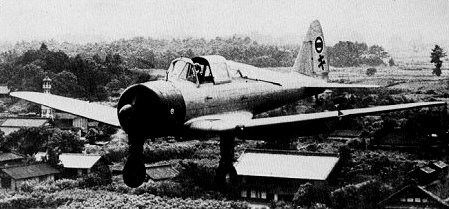
|
It goes without saying that the same photo appeared on dozens of Websites, most often to illustrate articles about the “Foo Fighters” written by non-ufologists. None gave any contextual information other than that which I found in bookish sources.
There has obviously never been a “sighting report” related to this image. My guess is that the Cosmic Brotherhood Association probably found the photo in some Japanese book or newspaper or magazine showing photos of airplanes, and, seeing the “bright spots”, they must have decided they were UFOs.
But the two “bright spots” could be reflections on the cockpit of the plane that took the photograph, obviously during the day. Two planes appear in the image, the photograph could only have been taken from a third plane.
Probable reflections on cockpit.
* = Source is available to me.
? = Source I am told about but could not get so far. Help needed.
| Main author: | Patrick Gross |
|---|---|
| Contributors: | None |
| Reviewers: | None |
| Editor: | Patrick Gross |
| Version: | Create/changed by: | Date: | Description: |
|---|---|---|---|
| 0.1 | Patrick Gross | October 28, 2023 | Creation, [odb1], [lpo1], [jsr1], [ues1], [bua1]. |
| 1.0 | Patrick Gross | October 28, 2023 | First published. |
| 1.1 | Patrick Gross | November 12, 2023 | Addition [ofr1]. |
| 1.2 | Patrick Gross | May 2, 2024 | Additions [tfo1], [epl1], [dce1]. In the Summary, addition of the information from [tfo1]. Case date changed from "1944 or 1945" to 1945. Location changed from China or the Pacific. |
| 1.3 | Patrick Gross | June 10, 2024 | Addition [wsd1]. |
| 1.4 | Patrick Gross | July 20, 2024 | Additions [rpi1], [ilb1], [gso1], [jbo1]. In the Summary, addition of the information from [gso]. |
| 1.5 | Patrick Gross | July 27, 2024 | Addition [rpi2]. |